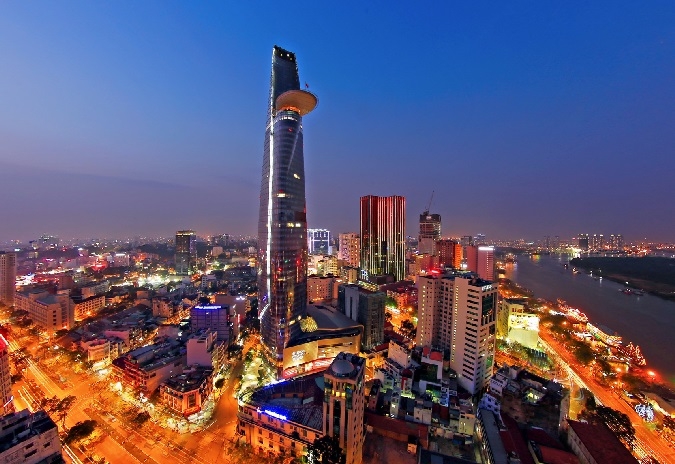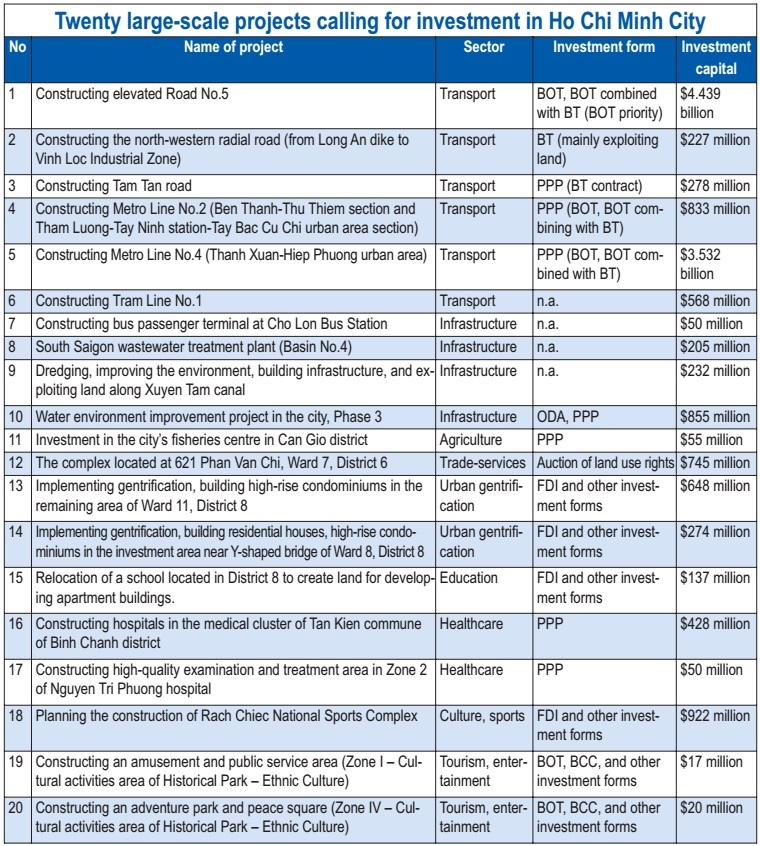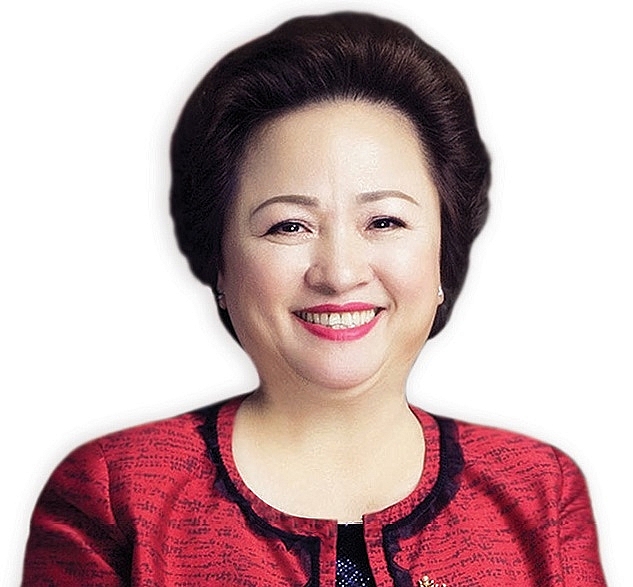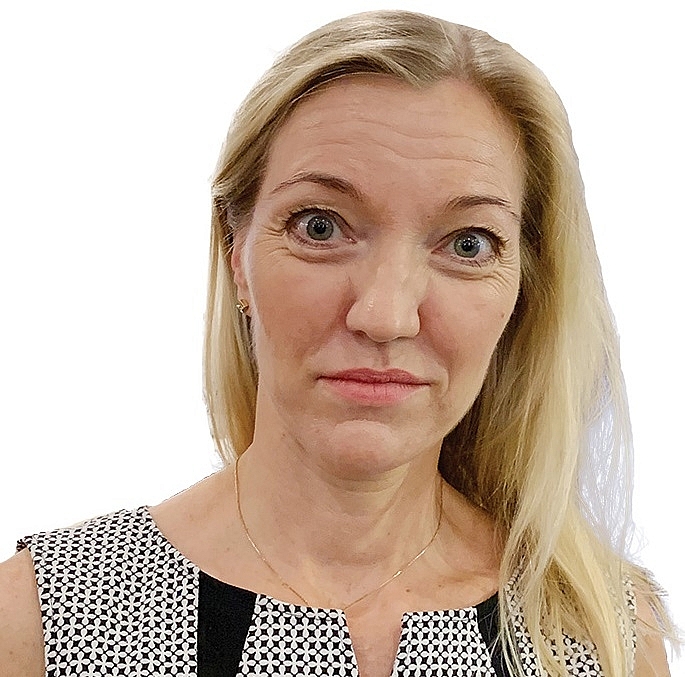Ho Chi Minh City calls for investors in 210 projects
 |
| Ho Chi Minh City, illustration photo |
In 2015, Emaar Properties from Dubai decided to co-develop a mammoth $1.42 billion urban area in Binh Quoi-Thanh Da of Ho Chi Minh City with domestic Bitexco Group. Despite having the requisite financial and technical capacity, Emaar Properties, however, had to withdraw from the project in 2017, after the compensation and land clearance was not completed in two years.
Also impacted by the sluggish compensation and land clearance, Hongkong Land, a company under Jardine Matheson Vietnam, in 2016 had to quit from a project on a golden land plot in the city centre.
Alain Cany, country chairman of Jardine Matheson Group, previously told VIR that despite the company’s tight co-operation with the city authorities, it was difficult to manage the delays caused by land clearance and compensation which also increased costs.
According to Nguyen Thanh Phong, Chairman of the Ho Chi Minh City People’s Committee, improving the investment environment and removing hurdles hitting investors like Emaar Properties and Hongkong Land is one of the most important issues for the city. “We have been pushing up administrative reforms and opened up favourable conditions for enterprises. As a result, more than 120 new enterprises are set up every day in the city,” Phong said at the investment promotion conference in the city last week.
However, he also admitted that local authorities have been struggling to keep up with their land clearance and compensation commitments.
According to Tran Vinh Tuyen, Deputy Chairman of the Ho Chi Minh City People’s Committee, the city authorities are improving land clearance and handover procedures, highlighting to VIR the in-principle commitment with the government to shorten the duration of these procedures from 420 to around 100 days.
“Many big investors have left because they could not wait out the 420 days for the processing of their projects, which brought a wide range of impacts, including investment diverting capital flows from the city and increasing the burden of bank loans,” Tuyen said.
Tuyen added that city leaders had mapped out transparent processes from the top to the grass-roots level to facilitate project implementation, especially by utilising technology.
Under this initiative, a special app is being set up to provide a detailed overview of each project and will be put into operation very soon, allowing public access to all information related to the projects, especially their progress and legal status, Tuyen said.
“This is a breakthrough in administration in Ho Chi Minh City. Via this app, all information will be transparent and accessible for all sides, especially investors who are looking for mergers and acquisitions deals,” Tuyen said.
The app would also push local authorities to publish and keep up with projects’ schedules.
“Transparency is very important because it reduces overlapping competences and irresponsibility by staff at local authorities, which make for today’s lumbering, burdensome bureaucracy,” he added.
In order to improve the investment environment, in 2018, the city set up three special management boards with the aim to better manage project implementation. These boards now manage transport projects, urban facilities, and civil and industrial projects.
According to Phong, during 2016-2020, Ho Chi Minh City needs investment of around $78 billion and the state budget can only meet 20 per cent of this.
The city is calling for investment for 210 projects with the total investment capital of VND1.18 quadrillion ($51.5 billion) in the fields of transportation, infrastructure, agriculture, trade and services, urban development, education, healthcare, sports, tourism, and entertainment (see the table below).
Transport on offers the most projects (85) with the total investment capital of VND923 trillion ($40.1 billion), including 55 projects in bridges and linking roads, seven waterway projects, eight urban railway projects, and 15 inner city road projects. In infrastructure improvement, the city is offering 36 projects with the total investment capital of VND108 trillion ($4.7 billion), including four car park projects, 28 projects on building technical infrastructure system, and four projects to prevent flood in the city.
The city offers nine trade and services projects, two agricultural projects, 29 urban development projects, 14 education projects, six healthcare projects, 15 sports and cultural projects, and 14 tourism and entertainment projects.
| Ho Chi Minh City is one of the fastest-growing cities in Vietnam, contributing 22 per cent of the country’s GDP, one third of the total industrial capacity, one-third of the total state budget, and one-fourth of the total export value of the whole country. As of the end of 2018, 101 countries and territories had investments in Ho Chi Minh City with a total of 8,112 projects, capitalised at nearly $45 billion. Last year alone, the city received $7.07 billion worth of foreign direct investment (FDI), up 7 per cent on-year, accounting for 22 per cent of the country’s total FDI figure. |
 |
| Nguyen Thi Nga - Chairwoman, BRG Group
In Ho Chi Minh City, BRG Group’s investment is still modest, considering our capacity. We see that the city is advanced in tourism, hotels, and leisure facilities. We are involved in a range of hotel projects in the city, such as Hilton Garden Inn, Crowne Plaza and Diamond Complex. We are also developing a leisure complex in Hoc Mon district and a Hello Kitty theme park in District 6. We are also very interested in the city’s creative urban area in districts of 2, 9, and Thu Duc. We highly appreciate Ho Chi Minh City’s efforts to improve procedures, especially the shortening of land clearance time, setting up special management boards, and using high technologies. These are all positive administrative reforms which will surely attract more investors to the city. Linson Lim - President Keppel Land Vietnam
I am very appreciative of Ho Chi Minh City authorities’ efforts to promote investment, as well as the strong collaboration and open dialogue that exist between the local authorities and the private sector. The Vietnamese economy may be impacted by the volatility of the global economic landscape, with concerns over trade tensions between the United States and China as well as slowing global growth. Notwithstanding, we are confident of Vietnam’s long-term prospects, and are committed to further strengthening our presence in Vietnam, with a focus on Ho Chi Minh City, which we believe will continue to be one of the country’s key growth locomotives. Keppel Land has about 20 licensed projects in Vietnam, with the total registered investment capital of over $3 billion. Our residential developments in the eastern and southern areas of Ho Chi Minh City have contributed to the city’s concerted efforts to develop new, thriving urban precincts to reduce the pressure on the infrastructure of the central business district of the city. Keppel Land has partnered up with Keppel Urban Solutions, an end-to-end master developer of urban developments, to develop Saigon Sports City into a bustling hub, combining high-quality urban living with vibrant and healthy lifestyle concepts. Magdalena Krakowiak - Vice chairwoman, Central and Eastern European Chamber of Commerce in Vietnam, and head of Public Affairs & CSR Vietnam, Adamed Group
We are interested in learning more for investors from Central and Eastern Europe regarding open investment and projects calling for investment in different fields of business. It is very good to know which projects are a priority for the local government because it helps us connect Central and Eastern European companies with better opportunities in Vietnam. There is a lot of interest from investors. However, there are still large holes in the regulatory framework, and the country lacks long-term incentives for investors to be more eager to develop their bonds with Vietnam and spend more money. Adamed Group – a pharmaceutical and biotechnology company from Poland – spent $50 million acquiring a 70 per cent stake in Dat Vi Phu Pharmaceutical Co., Ltd. We are investing in a local factory in the southern province of Binh Duong of EU GMP standards to increase production capacity and to produce higher-quality pharmaceutical products. |
What the stars mean:
★ Poor ★ ★ Promising ★★★ Good ★★★★ Very good ★★★★★ Exceptional
Related Contents
Latest News
More News
- Global partnerships key to Vietnam’s IFC development (December 26, 2025 | 16:18)
- Vingroup pulls out of bid to invest in North-South high-speed railway (December 26, 2025 | 11:42)
- Strengthening supply chains through trade promotions and customs reform (December 24, 2025 | 14:00)
- PM orders investment model for North–South high-speed rail (December 22, 2025 | 17:43)
- LS Eco Energy to invest in Vietnam rare earth sector (December 22, 2025 | 17:31)
- Government moves to establish International Financial Centre (December 21, 2025 | 21:00)
- Vietnam's IFC to target global investment flows (December 21, 2025 | 18:00)
- Two national hospitals expand capacity with new facilities (December 20, 2025 | 09:00)
- Ha Tinh breaks ground on major Vingroup industrial and energy projects (December 19, 2025 | 18:24)
- EVN launches major power infrastructure projects nationwide (December 19, 2025 | 18:17)




 Tag:
Tag:



















 Mobile Version
Mobile Version